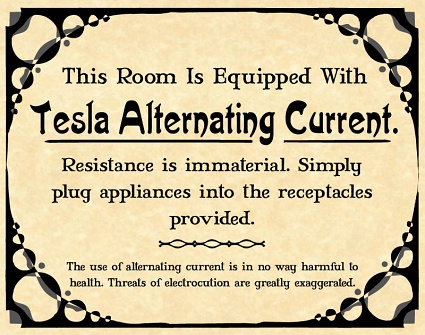Your room may be equipped with Edison electric light, but those new-fangled bulbs wouldn't be good for much more than pepper shakers if it weren't for a man named Nikola Tesla.
Before the turn of the century, Thomas Edison and Tesla were engaged in a battle known as the War of Currents. Edison was a staunch proponent of direct-current electricity, while Tesla was an advocate of alternating current. Tesla was confident that AC was the way of the future, but Edison had already sunk a great deal of time, energy and money into DC.
The problem was that DC required expensive, high-maintenance converters to transform between voltages. AC, on the other hand, could do the same thing with less expensive and more efficient equipment, making it more effective in overcoming current loss over great distances. Tesla knew this and continued to promote AC for wide distribution.
Edison wasn't ready to admit his system's shortcomings, though, and in retaliation, he arranged publicity stunts in which he electrocuted dogs, horses, even an elephant, using AC in an attempt to show how dangerous AC was and to discredit Tesla. (Edison did not, of course, reveal that DC would've killed the animals all the same.)
Regardless, Tesla eventually proved the value of alternating current, and AC subsequently became the power of choice for American homes and businesses. Resistance, from neither copper nor Edison, remained a problem.
In honor of his accomplishment, I've designed a vintage-style sign similar to this one in an attempt to attribute a fair share of the credit to Nikola Tesla for those gasless lamps you're now enjoying.
You can download the sign below to print one of your own. The PNG is optimized for a typical letter-size sheet and the PDF is vectorized for lossless resizing.





12 Comments
I might be wrong because I'm just working of memory but I think you mixed ac and dc up. dc electrocuted the elephant and is more dangerous but has lower resistance. ac was proposed by edison and is inferior(also only used in north america)
That's why it's best not to work from memory. :)
What Wesley said.
yeah, seriously. please do some basic research
LOL somebody call the retard catcher! Just kiddin man, just kiddin, but for real, no actually that's the opposite of what's correct. NBD tho, I had exams this week so I prolly missed about 80 multiple choice questions this week. Of course, those were with 4 or five answers...
You sir are an idiot!!!! Thomas Edison didn't do much of anything (no, he didn't even invent the incadescent light!). Since he wasn't educated he didn't understand how inefficient HIS Direct Current system was. Tesla went to work for Edison, who offered him $50,000 if he could improve the design of his inefficient D.C. generators. After Tesla showed Edison the improved generator and demanded his $50,000, the immoral Edison refused, saying he was just joking. Tesla went on to develop the Alternating Current generator, build the worlds first hydro-electric generating plant at Niagra Falls. He also invented the A.C. motor, which you'll find everywhere in the world (even in the U.S.!!!!). He also held most of the patents that Marconi used to claim he'd developed radio (the supreme court later (in the 30's) corrected the errors of the past and named Tesla the inventor of Radio.
Oh, and about you being an idiot: Don't feel too bad, you're just one of about 90% of the U.S. population that are idiots!
No, he got it right. Tesla invented AC, which is safer due to the current alternation 'letting go' if you're electrocuted, instead of holding on to you until you're crisp. It also allows electricity to travel long distances. With Edison's DC there would have to be a power plant every few miles.
You neglected to mention that in this "battle of the currents" Tesla also shot lightning bolts from his finger tips using AC current. Edison was nothing compared to the genius of Tesla. He just hired smart people and stole their patents. Look into how Tesla got ripped off by Edison when he made Edison motors more efficient.
amps X voltage = power/watts. smaller wires have more resistance than bigger wires, thus they can't hold the same amperage as a larger wire without burning up. there is something also called voltage drop. over long distances voltage will lower from the original amount because of the resistance of the wire. The solution to this is provide a bigger wire(less resistance). Big wire costs a lot and so does a power plant every mile or so.
AC on the other hand can be transformed, if an area needs 50000 watts then you can "step up" the voltage to say 1000 and only run a wire that can hold 50 amps. Where as DC 50000 watts/120v =416 amps or a very large wire. That is a main cost benefit of AC. Voltage drop is also an issue for AC but the amount of drop affected at 1000 volts then transformed back down to 120 becomes much smaller and thus easier to fix.
Pretty sure Tesla was AC
Pretty sure you have no reading comprehension.
Love the vintage style sign. It's good that a story as tragic as Tesla's is finally being recognized for the genius of its character; it's unfortunate for all of us that it comes as too little, too late.